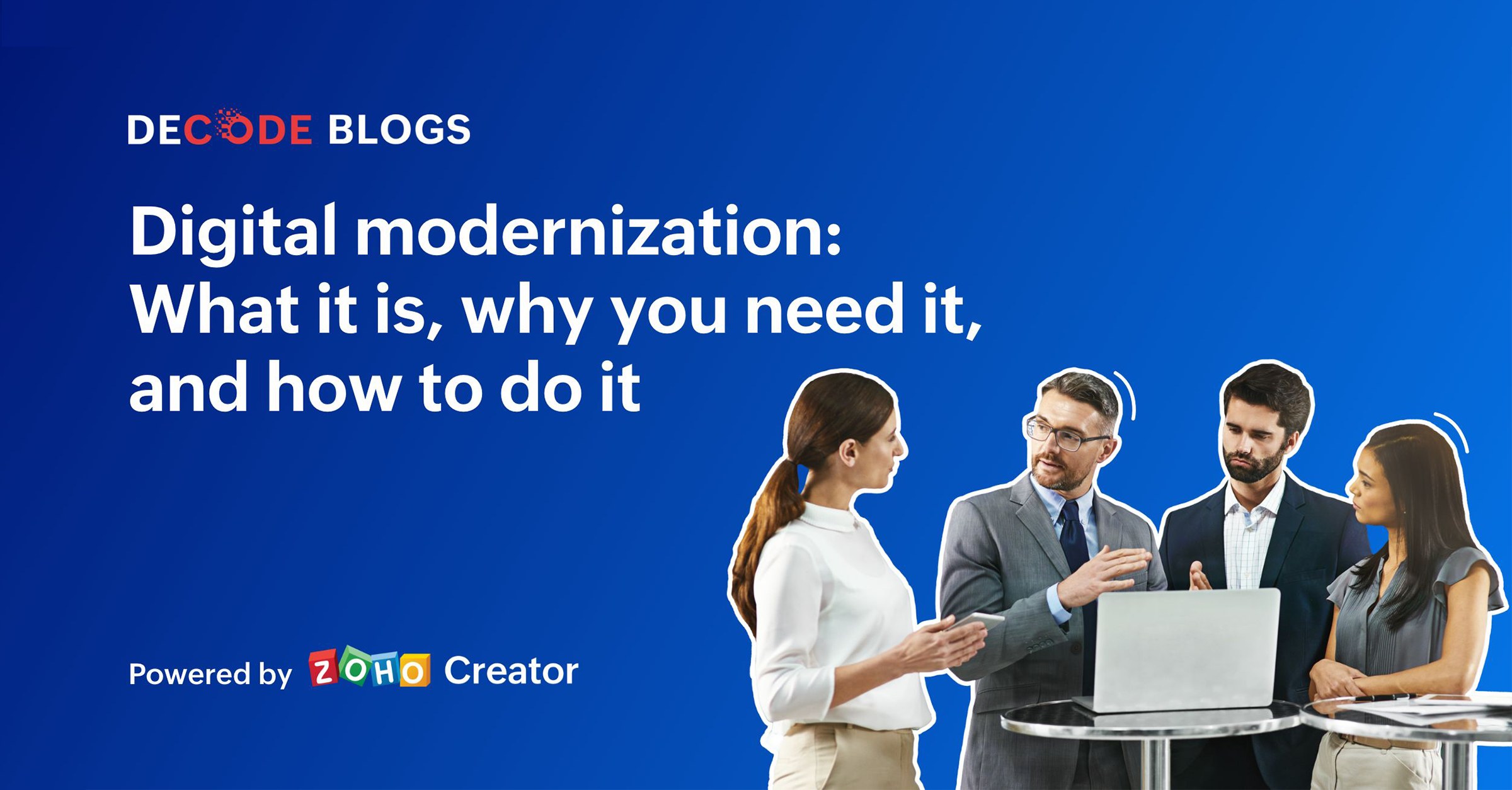- HOME
- Know Your Tech
- Digital modernization: What it is, why you need it, and how to do it
Digital modernization: What it is, why you need it, and how to do it
- Last Updated : April 20, 2023
- 2.4K Views
- 4 Min Read

The word digital has many meanings, but when we say digital modernization, we mean modernization in support of a digital transformation initiative.
In other words, there are many parts of the enterprise IT landscape that you might want to modernize. But which modernization challenges should you undertake in order to support your digital transformation efforts?
The fundamentals
Digital transformation is a multifaceted set of initiatives that seek to break down organizational silos to better align the enterprise with customer needs.
Technology is unquestionably a key driver of digital transformation, but the customer must be at the center of any successful initiative. As we like to say, digital transformation is software-empowered but customer-driven.
The transformation of organizational silos also has a fundamental technology component. As Conway’s Law suggests, the organization of a company’s technology tends to follow the organization of its people, and vice versa.
In other words, any enterprise with a siloed organizational model—different business units, say, or different departments—will end up with siloed technology stacks for each of these different organizational units.
Over time, then, every organizational silo within the organization ends up with its own legacy challenges—and thus, its own modernization opportunities.
Prioritizing modernization efforts for digital transformation
Different organizations face different challenges and pursue different goals. As a result, every digital transformation effort is unique and specific to the transforming enterprise in question.
Nevertheless, there are some core principles for deciding which modernization efforts are particularly important for digital transformation—those projects we’re going to call digital modernization efforts.
The first and most important principle: focus on the customer experience (CX) and, to some extent, the employee experience (EX).
The starting point for any digital transformation effort has to be the customer (where we consider employees as a type of customer in the sense that IT must serve them, as well).
Modernizing the CX, therefore, should be top priority. Are the applications that customers (and employees) interact with fully modern? Do they support all customer requirements? Do they work across any device or other touchpoint important to your customer base?
The second principle to consider when prioritizing digital modernization: cross-departmental process transformation. Organizations must typically rework their business processes to align them with customer and employee requirements, instead of aligning them with internal organizational silos.
For example, do you have end-to-end customer journeys that support customer needs (rather than simply supporting sales priorities)? Are employee-facing processes, like new hire onboarding, seamless across all interactions with various departments?
The third principle is a fundamental best practice across all IT projects and initiatives, but is especially important in the context of digital modernization: if it ain’t broke, don’t fix it.
The enterprise IT landscape is chock full of older applications, out-of-date platforms and systems, and all manner of other legacy gear. Simply because something is old or uses obsolete tech, however, doesn’t automatically mean you should modernize it.
Consider first whether it’s meeting customer needs today, and whether some other project would be a better place to spend limited modernization dollars.
In the context of digital modernization, look to the first two principles: CX focus and process transformation. If a potential modernization project doesn’t align with either of these, then it may not be the best use of your resources.
Why low-code is the key to digital modernization
There are many modernization technologies and products on the market, ranging from COBOL language translators to cloud migration tools. Any modernization effort is likely to leverage some mix of these tools.
From the perspective of digital modernization, however, all of these tools align with and reinforce existing technology silos. They may be a necessary part of a digital transformation effort, but they don’t help the organization with the fundamental digital modernization priorities listed above.
To succeed with digital modernization, organizations require complementary technology that both fosters collaboration across organizational silos while acting as the ‘glue’ that connects disparate modernization efforts.
Low-code tools and platforms like Zoho Creator are the solution.
Not only does low-code empower both professional and non-technical, citizen developers to build applications, but the platforms also foster collaboration across teams—as well as the business stakeholders driving the applications.
Furthermore, low-code tools can connect to a wide variety of existing applications and other technologies, either via built-in connectors or via modest additional hand-coding.
Once the low-code platform has access to such resources, the collaborative application team can incorporate those resources into customer-focused, cross-organizational applications; just what organizations need to succeed with digital modernization.
The Intellyx take
There are many different uses of low-code technologies in support of digital modernization, depending upon what the organization is transforming at the time.
The organization might be reworking its business process in furtherance of process transformation efforts. Here, low-code tools provide a collaborative, customer-focused approach to such a rework.
In other cases, the organization is focusing on application modernization in order to support a customer-centric mobile-first strategy. Low-code can be the perfect tool to support such a strategy.
Enterprises might even be working on one or more infrastructure modernization initiatives, like cloud migration or implementing Kubernetes as part of a cloud-native computing strategy.
Low-code can even facilitate such initiatives, as it brings collaboration, rapid application construction, and customer-centricity to even the most technically complex infrastructure modernization efforts.
Even such fully modern infrastructure initiatives can still fall into older, siloed organizational patterns. For digital modernization to succeed, people within the organization must take an active role in avoiding such patterns.
Low-code tools and platforms can be instrumental in moving such enterprises forward with digital modernization, and thus with their broader digital transformation efforts.
Copyright © Intellyx LLC. Zoho is an Intellyx customer. Intellyx retains final editorial control of this article.
 Jason Bloomberg
Jason BloombergJason Bloomberg is a leading IT industry analyst, author, keynote speaker, and globally recognized expert on multiple disruptive trends in enterprise technology and digital transformation. He is ranked #5 on Thinkers360’s Top 50 Global Thought Leaders and Influencers on Cloud Computing for 2020, among the top nine low-code analysts on the Influencer50 Low-Code50 Study for 2019, #5 on Onalytica’s list of top Digital Transformation influencers for 2018, and #15 on Jax’s list of top DevOps influencers for 2017.



